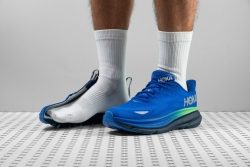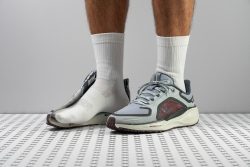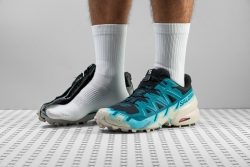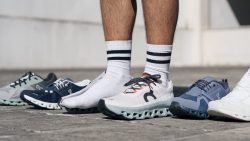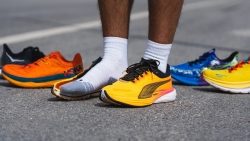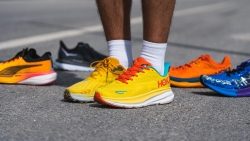4 Best Gore-Tex Running Shoes in 2025

We buy shoes ourselves. We earn commissions when you buy through us, at no extra cost. Why trust us
Gore-Tex running shoes are a great option if you live in a region where it rains a lot or in a snowy climate where snowflakes seep in with every step. In this guide, we cover every little detail about Gore-Tex running shoes. We even prove the brands wrong by showing how non-breathable these shoes are contrary to the specifications.
Next to super-specific upper tests that we did in our shoe lab, we also did test runs in all of these GTX shoes. Having all the lab tests and test runs under our belt, we were able to handpick these superb Gore-Tex running shoes in different categories. You can also read why we think they excel at what they do!
How we test Gore-Tex running shoes
To make the cut of our ultimate best selections, we put all the Gore-Tex running shoes on this list through a rigorous testing process. Here is a quick look at how we do our extensive reviews:
- To remain unbiased, we buy all GTX running shoes with our own funds.
- We run with each pair multiple times and expose them to different weather conditions to experience their waterproofness and breathability first-hand.
- We cut these shoes in half in our lab and perform dozens of tests. Once they are cut in half, it's easy to notice the Gore-Tex membrane as a second layer, just under the upper. What's interesting is that it's not glued to the upper, so having 2 layers usually explains why the breathability isn't good.
Best Gore-Tex running shoes overall
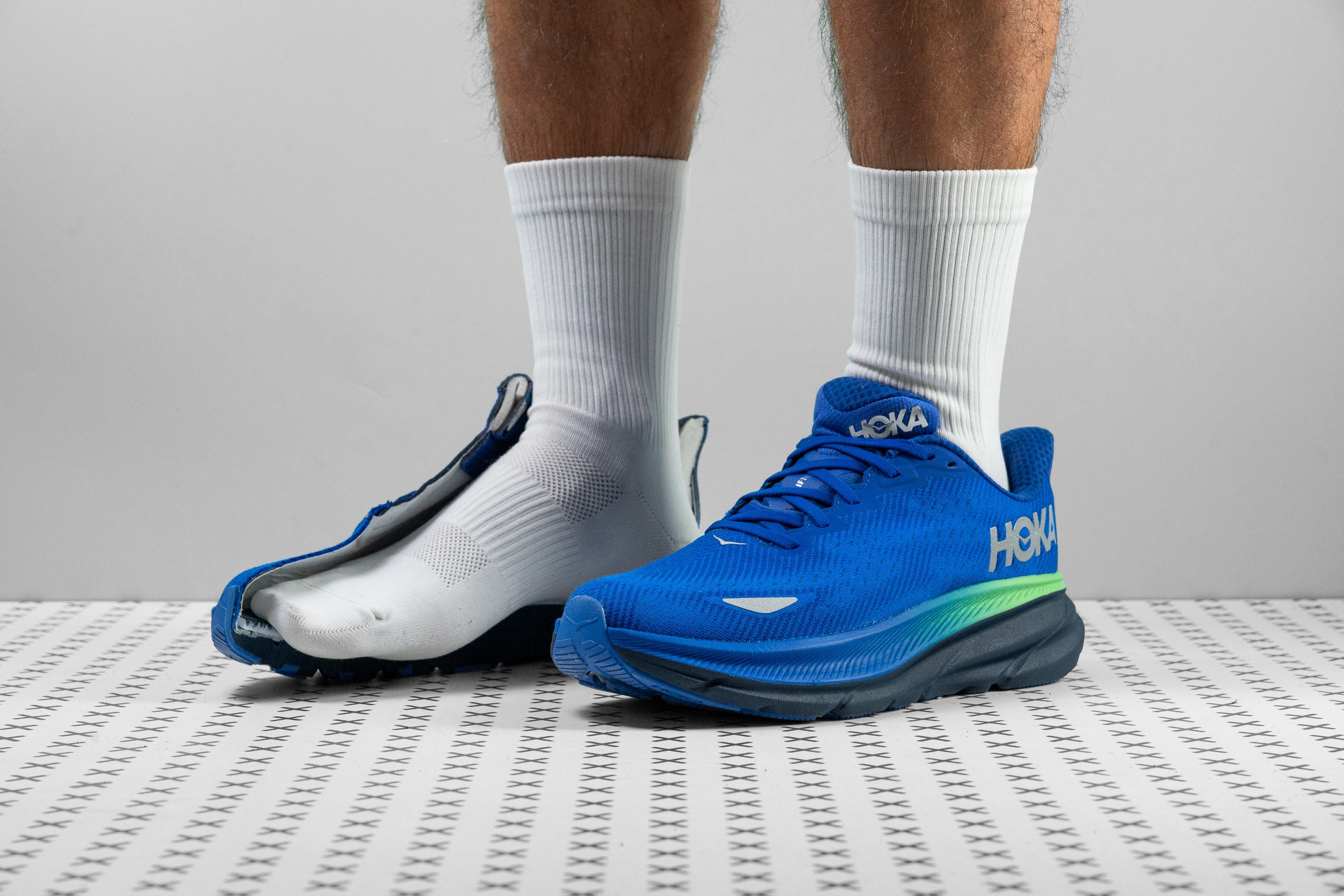



















































What makes it the best?
Among Gore-Tex running shoes, our top pick is none other than the Hoka Clifton 9 GTX. Other than its comfort and protection in our runs, it impressed us greatly in the lab with its lightweight yet sturdy design.
The generous cushioning of the Clifton 9 GTX provides gentler landings for all types of foot strikes, with an above-average stack height of 37.2/28.6 mm. It feels balanced through its wide design, measuring 120.9/97.2 mm, which enhances stable landings.
Featuring a Gore-Tex membrane, this shoe delivers reliable waterproofing in rainy conditions, even with its remarkable 3/5 breathability score in our lab test—an uncommon feat for GTX shoes that usually score 1/5. The tightly knitted jacquard mesh fended off damage in our tests, scoring a solid 4/5 for durability.
Underneath, the Durabrasion rubber outsole provides sturdy protection against abrasions, showing 50.0% less damage compared to the average. Despite all the added features, the Clifton 9 GTX remains relatively light at just 9.6 oz (271g).
However, individuals with wide or squared feet may find the aggressive tapering of the toebox restricting, measuring 69.4 mm in the big toe area vs. the 73.3 mm average.
Pros
- Exceptionally cushioned
- Comfortable and long-lasting upper
- Ideal for winter conditions
- Only $15 more expensive than the non-waterproof Clifton
- Still remarkably lightweight even with Gore-Tex
- Excellent for easy and moderate-paced runs
- Incredibly stable for neutral runners
- Ultra-durable Durabrasion outsole
Cons
- May be too narrow for many
- Heel-to-toe drop significantly differs from Hoka's claims
- Not enough energy return
- It needs more grip in wet surface
Gore-Tex running shoes with the best shock absorption





















































What makes it the best?
In our runs and lab tests, no Gore-Tex running shoe can match the shock absorption of the Nike Pegasus 41 GTX, especially for heel strikers. We experienced confident footing and underfoot protection like no other through its cushioned and grippy base, with an effective block against cold and water to boast.
Using our calliper, we discovered that it features an above-average 36.3 mm heel, offering impact protection as confirmed with its 129 SA or shock absorption rating. It has a cushioned sensation, ensuring our feet don’t feel harsh landings and underfoot debris too much.
Beneath the midsole is the Storm-Tread outsole, tailored for wet conditions. With its solid grip and capability to channel water away, we felt in control as we navigated through rain or snow.
The upper features a Gore-Tex membrane, keeping our feet away from cold winds and water. Smoke was effectively contained when we pumped it into the shoe, which is why we gave it the lowest 1/5 breathability rating. This score is what we want to see in waterproof shoes.
However, the toebox has limited space. Runners with wide feet will need to find a shoe with a more accommodating fit.
Pros
- Waterproof Gore-Tex membrane
- Dual Air Zoom units
- Improved tongue padding
- Durable yet comfy upper
- Rugged toe bumper
- ReactX bouncy foam
- Keeps feet warm
- Reliable grip on wet surfaces
- Amazing for heel strikers
Cons
- Tapered toebox
- Heavy
- Outsole durability concerns
- Maybe a bit pricey
Gore-Tex running shoes with best durability
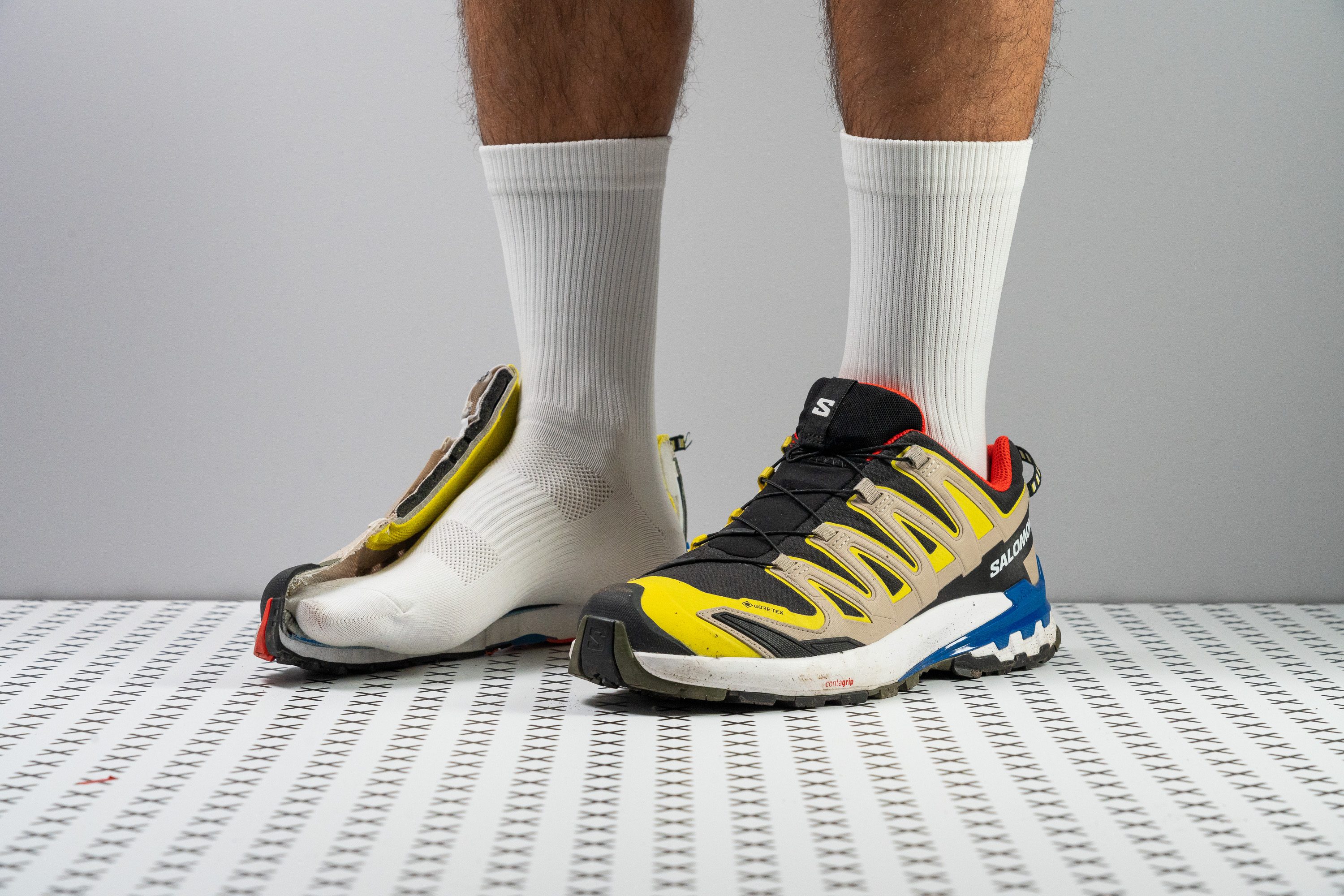













































What makes it the best?
Our trail runs prove Salomon XA Pro 3D v9 GTX has the best durability among Gore-Tex running shoes. With the lab as our witness, it is an all-around shield with its tightly knit upper, firm cushion, and ever-reliable Contagrip outsole.
Wrapped in Gore-Tex, it has outstanding waterproofing and our lab tests confirm its impermeability with the lowest 1/5 score. It not only blocked smoke out but light too! We didn’t need to worry about painful toe stubs because the toe bumper is our armour. It braved our Dremel test and scored the highest 5/5 for toebox durability.
The firm midsole and 3D chassis also serve as our defence underfoot. Not only do these protect us from sharp rocks, but they also enhance stable strides. Our durometer confirms the platform is 23.6% firmer than average.
The ‘Contagrip’ outsole, aided by the 2.8-mm lugs, obliterated most terrains we ran in except the really technical ones. After running in harsh environments, the outsole barely showed signs of premature wear—a plus for durability.
All the added protection comes at the expense of more weight. While most trail shoes average 10.4 oz (294g), this one feels like a hiking shoe at 12.7 oz (359g).
Pros
- Incredibly protective
- Extremely stable and supportive
- Watertight Gore-Tex upper
- Flexible and forgiving on the foot
- Makes a great hiking companion
- Effectively dampens landings
- Generously padded from heel to tongue
- No lace bite whatsoever
- Durable, high-quality construction
- Simple yet snazzy design
- Simple yet snazzy design
Cons
- Could be lighter
- Rather firm cushioning
- Upper needs breaking in
- Lacks the agility for technical trails
Gore-Tex running shoes with the best traction

















































What makes it the best?
Our lab and run tests prove Speedcross 6 GTX is protective from top to bottom — ranking first in terms of grip among Gore-Tex running shoes. We can speed through rainy days and river crossings with its deep, sticky lugs and waterproof membrane. The platform combines soft and rigid elements to ensure comfort and support through trail adventures.
Speedcross displays excellent traction in our fast-paced training. Our calliper measures its lugs at 5.0 mm deep, 1.5 mm deeper than average for that extra bite on soft ground. They’re widely spaced to shed off dirt and chevron-shaped to enhance control on sharp turns and steep slopes.
Underfoot, we have a firm cushion that improves our balance on uneven terrains. Our durometer it's 21.3% harder than average. The midsole is hard to twist earning a 5/5 on our manual assessment. This ensures stability and agility on challenging terrains. Yet in terms of longitudinal flexibility, Speedcross feels fluid. Our bend test confirms it’s 20.5% more adaptive than average.
During our runs, Gore-Tex feels impermeable. Our observations were confirmed as we saw one of the densest mesh uppers under our microscope. It has no ventilation holes for air and water to pass through, effectively keeping our feet dry.
Because of its limited breathability, Speedcross performs best in cold weather. Using this pair in the summer traps body heat and drenches our feet in sweat.
Pros
- Fully functional Gore-Tex membrane
- Ample cushioning for long adventures
- Excels in challenging, technical terrain
- Rapidly sheds mud
- Agile and tenacious grip on twisted trails
- Remarkable durability
- Ideal for heel strikers
Cons
- Completely lacks breathability
- Midsole could feel overly firm for some
- Exceptionally heavy
- Narrow, snug-fitting toebox
3 downsides of Gore-Tex running shoes
Maybe you’re here for the hype, so let’s make sure you know what you’re getting yourself into:
- Gore-Tex running shoes are not breathable. If you use them in warmer climates, your feet will sweat and the sweat buildup might lead to discomfort, blisters, and so on.
- Once water gets inside the Gore-Tex running shoes, it does not get out. They are not breathable enough for the water to get outside and for the shoes, along with your feet and socks, to dry out.
- Running shoes with a Gore-Tex membrane tend to be more expensive than those with no waterproof membranes.
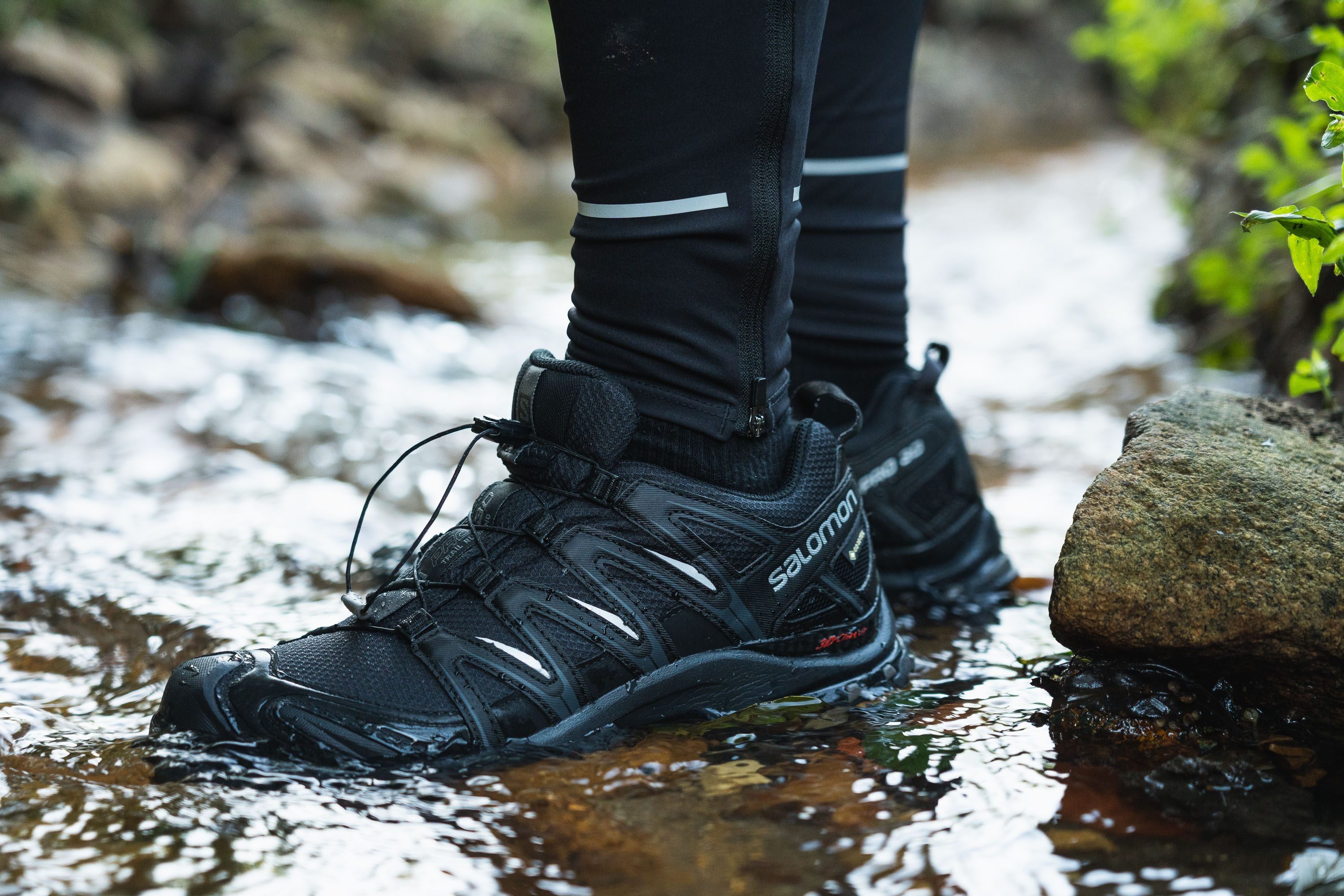
How to recognise Gore-Tex running shoes
If a shoe features a Gore-Tex membrane, you’ll see a Gore-Tex patch on the upper.
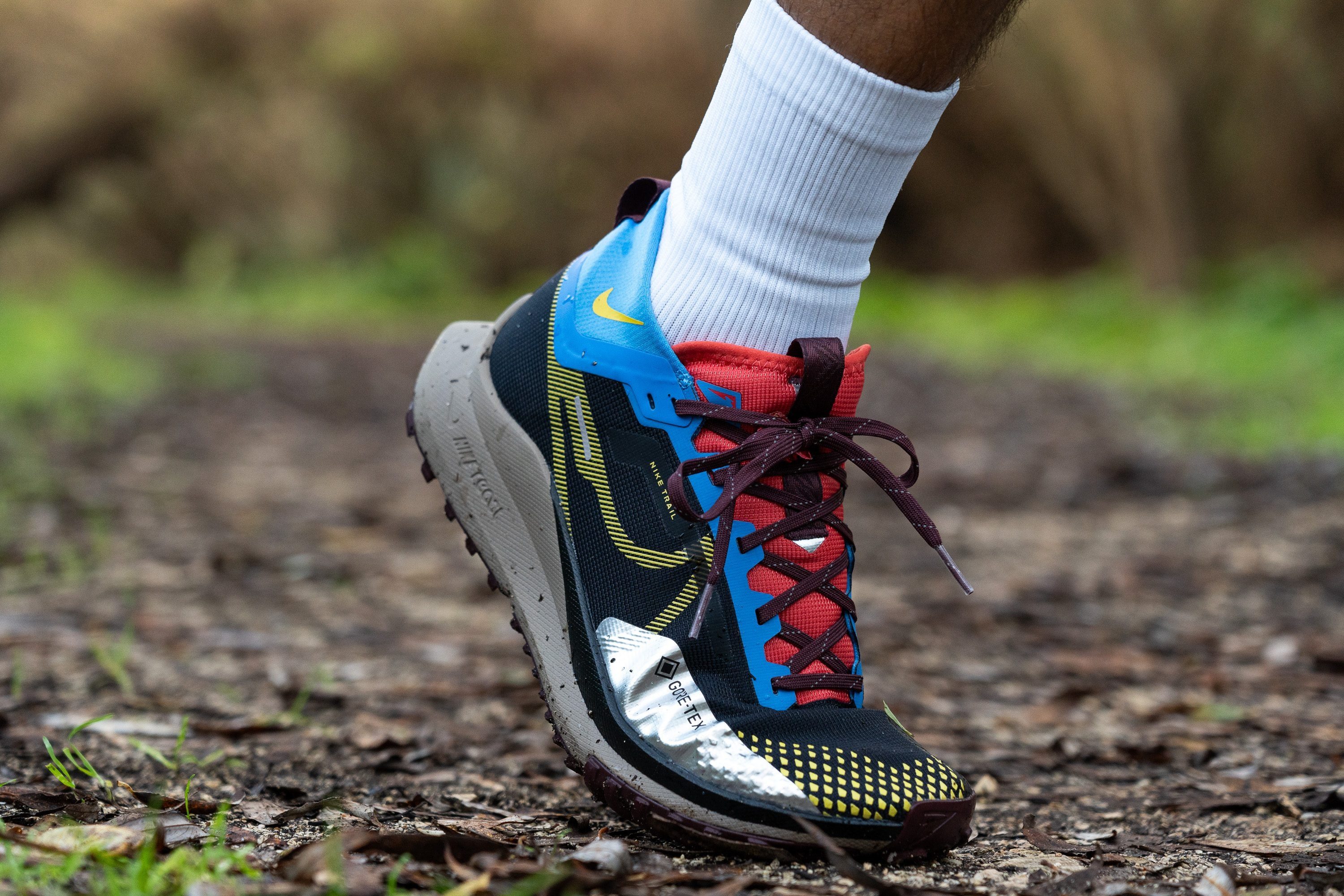
When it comes to the shoe names, they all include Gore-Tex or GTX.
These are NOT breathable
In theory, the Gore-Tex membrane works in a way that it allows the air out and does not allow the water in.
However, from our extensive experience AND lab tests, we’ve come to the conclusion that GTX running shoes are not breathable.
In our lab, we pump the smoke into the shoes to assess breathability on a 1-5 scale. We do this by watching where the smoke comes out and at which pace. Usually, GTX shoes score 1/5 which is the worst breathability rating a shoe can get.
To learn more about this, we’ve put the Gore-Tex upper under the microscope, just like all the other uppers.
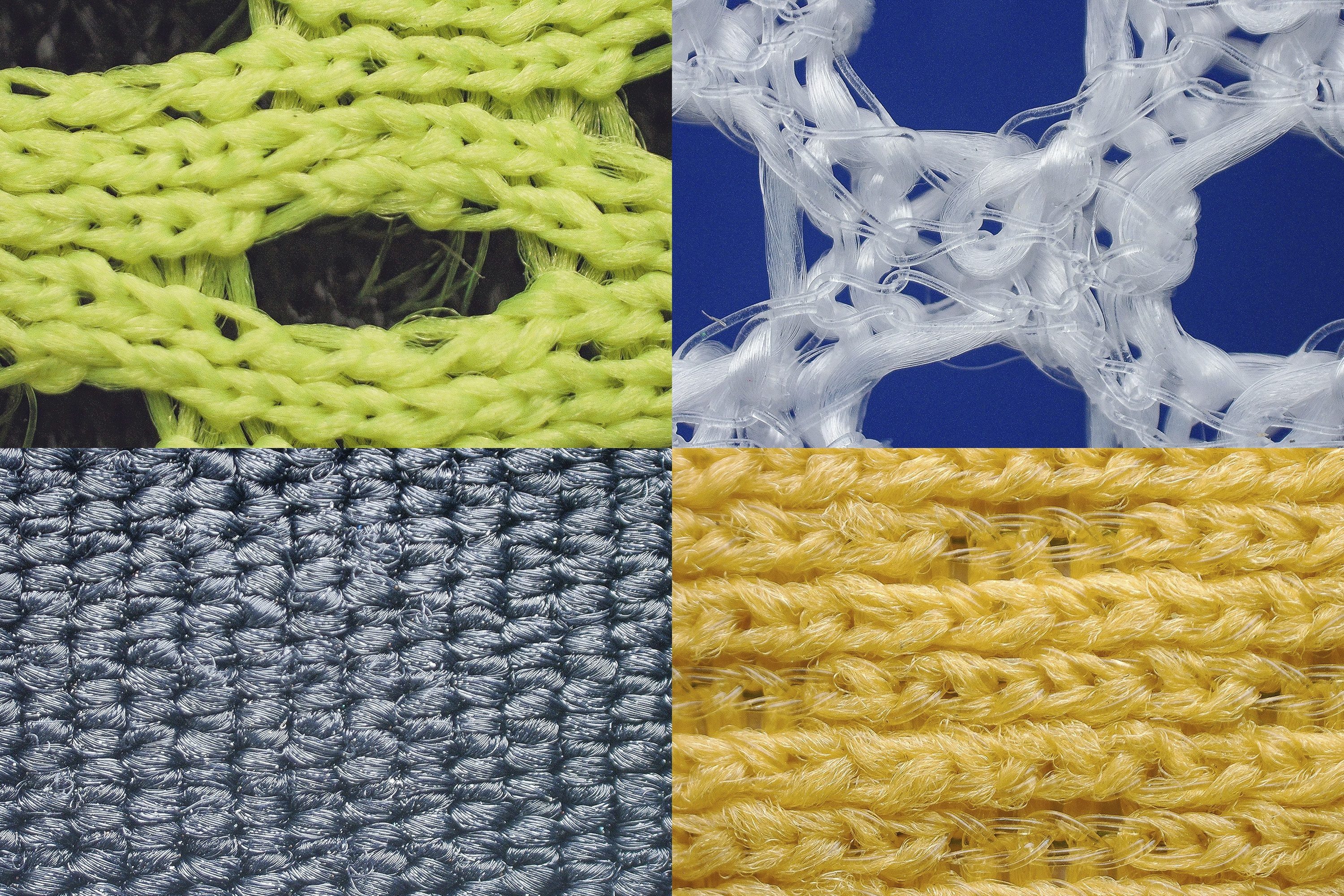
But, even without the microscope, once the shoes are cut in half, it’s easy to see why they do not breathe as much. There’s an additional layer (usually grey-coloured) that is actually the Gore-Tex membrane. So, the upper is 2-layered.
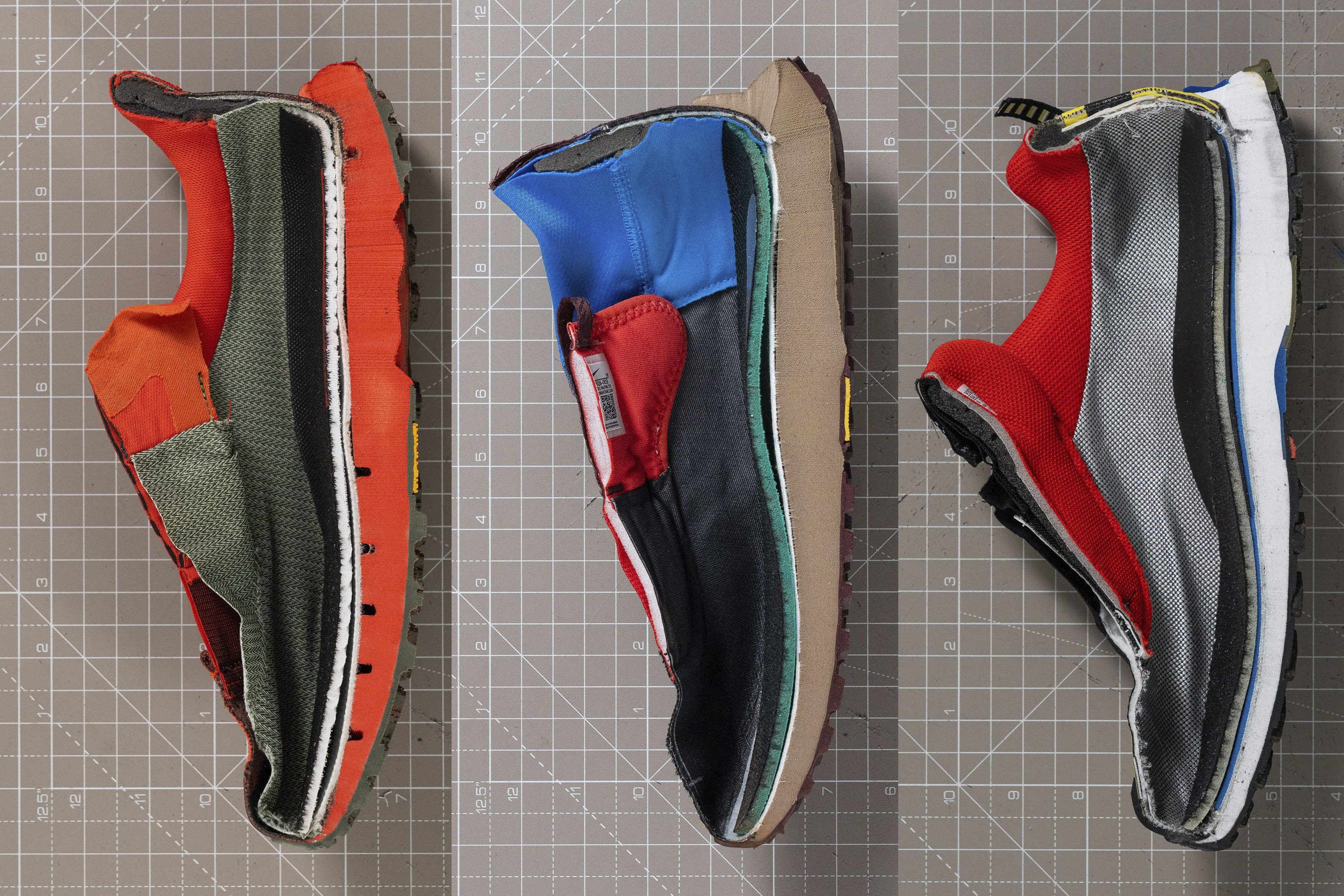
Grippy Gore-Tex running shoes: how to find them
When it comes to grip, many things come into play: the thread pattern, softness of the rubber, durability of the rubber. In trail shoes, we also take the depth of the lugs into account, their orientation, distance between each other, and so on.
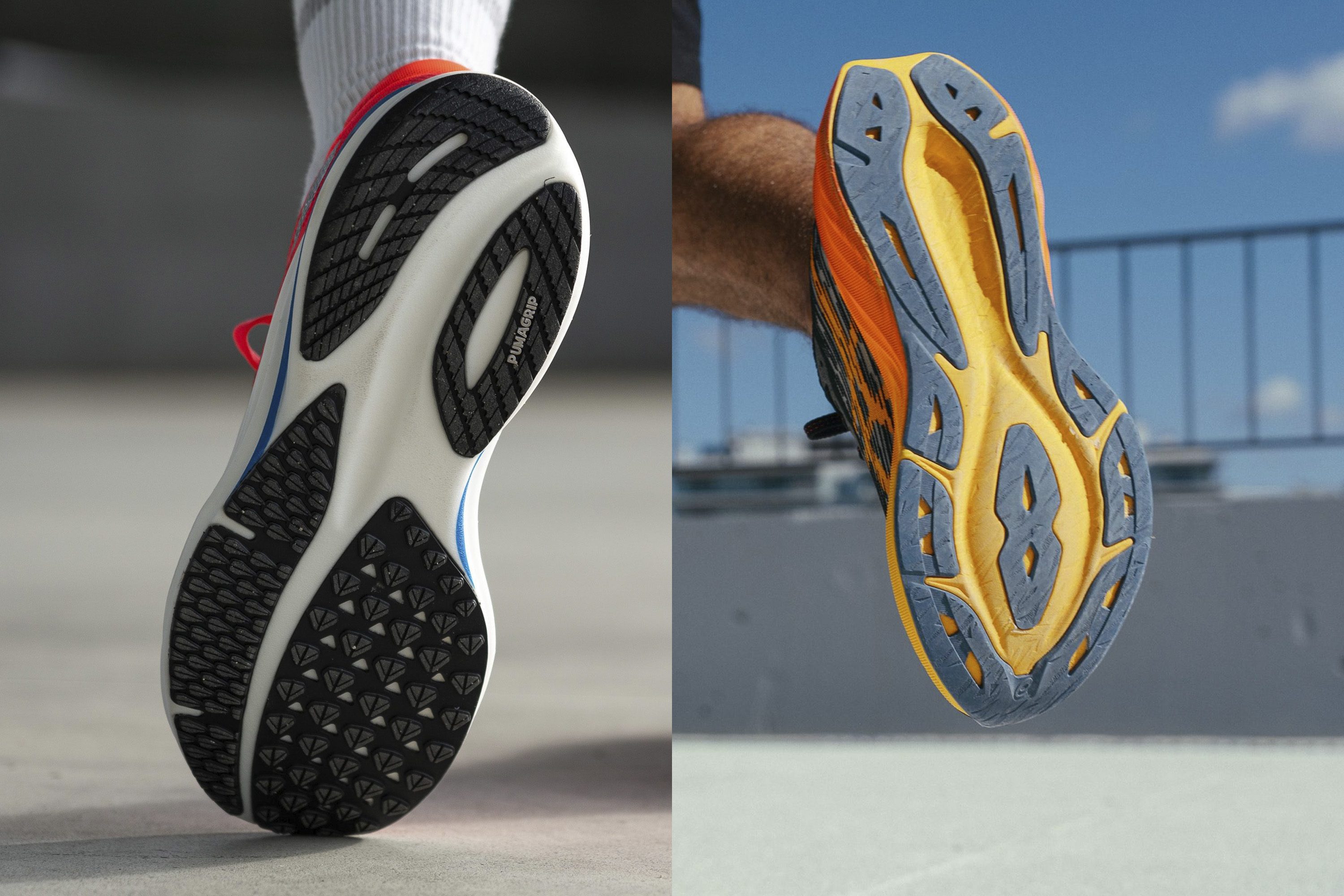
In road shoes, it’s best to look for as much rubber coverage as possible, because the exposed midsole simply slides on wet surfaces. And, look for channels and grooves, the more the merrier.
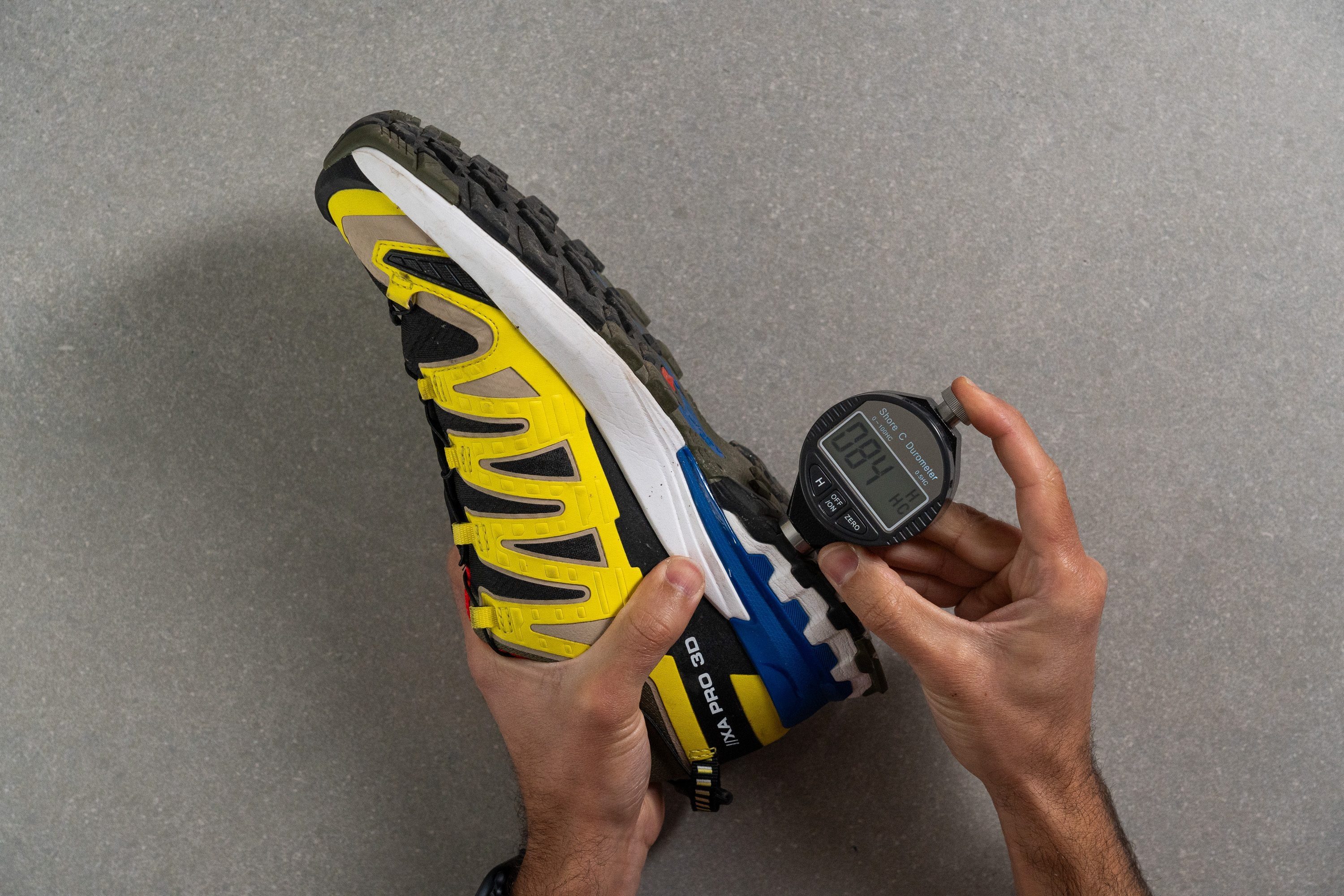
Harder rubber is usually more durable and protective, while softer rubber is stickier and more flexible. For context, here’s how hard the rubber is in best-rated Gore-Tex running shoes is:

In trail shoes, these are general guidelines:
- Deep lugs (4mm and above) work great in snow, slush, mud
- Medium lugs (2-4mm) are great for mixed terrain
- Shallow lugs (less than 2mm) are usually found in road-to-trail shoes (hybrid shoes) and are best used on hard ground

When NOT to use Gore-Tex running shoes
Don’t use GTX running shoes if:
- You’ll most likely encounter only a few short and shallow wet sections like puddles or slush. Shoes that do not feature a Gore-Tex membrane are more breathable, so even if your feet get wet, the chances are that the shoes and socks will dry out if you keep running, thanks to the warmth of your feet
- The terrain you plan to cover has water levels that are far too deep. In this case, either opt for Gore-Tex hiking boots or get Gore-Tex gaiters. They will keep your feet dry even when the water slides down the legs/trousers/gaiters.
- It’s very hot outside and your shoes are proven to be not breathable. Accumulated sweat can lead to blisters, to start with.
If the rain won’t be pouring, you might be OK with water-resistant or water-repellent shoes.
| Water-resistant | Water-repellent | Waterproof | |
| General characteristics | a tightly woven fabric that is naturally capable of resisting water upon contact | fabric treated with durable water-repellent (DWR) or hydrophobic chemicals | - fabric treated with DWR - have waterproofing membranes like Gore-Tex and OutDry - have seam-sealed construction for extra protection |
| Water protection level | low water protection | moderate water protection | high water protection |
| Water pressure resistance | 0-5000 mm (no pressure or moisture) | 6000-10000 mm (light pressure) | 10000-20000 mm (high to very high pressure) |
| Weather conditions best used in | light rain shower and dry snow | light rain and average snow | moderate to heavy rain and average to wet snow |
Just how waterproof Gore-Tex really is?
It depends on the hydrostatic head of the membrane used in the shoes you’re planning to buy. The hydrostatic head basically tells us how many millimetres of water can be poured into a 1’’x1’’ tube on top of the material until that water leaks through.
Based on this, you can look for the hydrostatic head in the specifications and decide whether the protection you’re getting is enough for the weather conditions of your runs.


